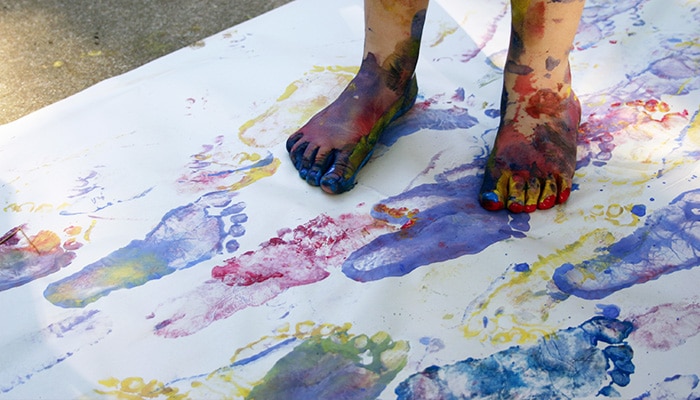While we believe that the books and resources recommended may be of value to you, keep in mind that these are suggestions only and you must do your own due diligence to determine whether the materials are appropriate and suitable for your use. PNC has no sponsorship or endorsement agreement with the authors or publishers of the materials listed.
ANIMAL FRIENDS

Animal Tracks
Children will investigate animal footprints.

Lesson Objective
The children will make footprints and compare them to different types of animal tracks.
Science
What You'll Need
- Pictures of animal footprints, such as deer, rabbit, bear, fox, squirrel, raccoon, wolf (see Lesson Tips)
- Pictures of animals that match those tracks (see Lesson Tips)
- Butcher paper – 1 strip about 6' long
- Tempera paint – 1 bottle, any color
- Paintbrushes – for adult use
- Paper plates – 1 per adult
- Basin with soapy water
- Towels
What To Do
Note: Before the activity, place some paint on a paper plate for each teacher who will be painting the children’s feet.
- Display and discuss the animal pictures and corresponding footprints (see Guiding Student Inquiry).
- Have the children notice different aspects (number of toes, pads of feet, and claws) of each of the different footprints.
- Explain that the children will be making footprints using paint on paper and then comparing them with the animal footprints.
- Working with one child at a time, paint the bottoms of the children’s feet with the paint, ask them to describe how this feels, and have them walk on the butcher paper (see Lesson Tips).
- Label each child’s footprints.
- Wash off their feet in the basin, and dry with a towel.
- When the children’s footprints are dry, have them compare their footprints to the animal footprints (see Guiding Student Inquiry).
Resources
Home School Resources
Home educators: use these printable lesson PDFs to teach this lesson to your home schoolers. They're available in English and Spanish.
Content Provided By
Common Core State Standards Initiative – These lessons are aligned with the Common Core State Standards ("CCSS"). The CCSS provide a consistent, clear understanding of the concepts and skills children are expected to learn and guide teachers to provide their students with opportunities to gain these important skills and foundational knowledge [1]. Visit the CCSS


